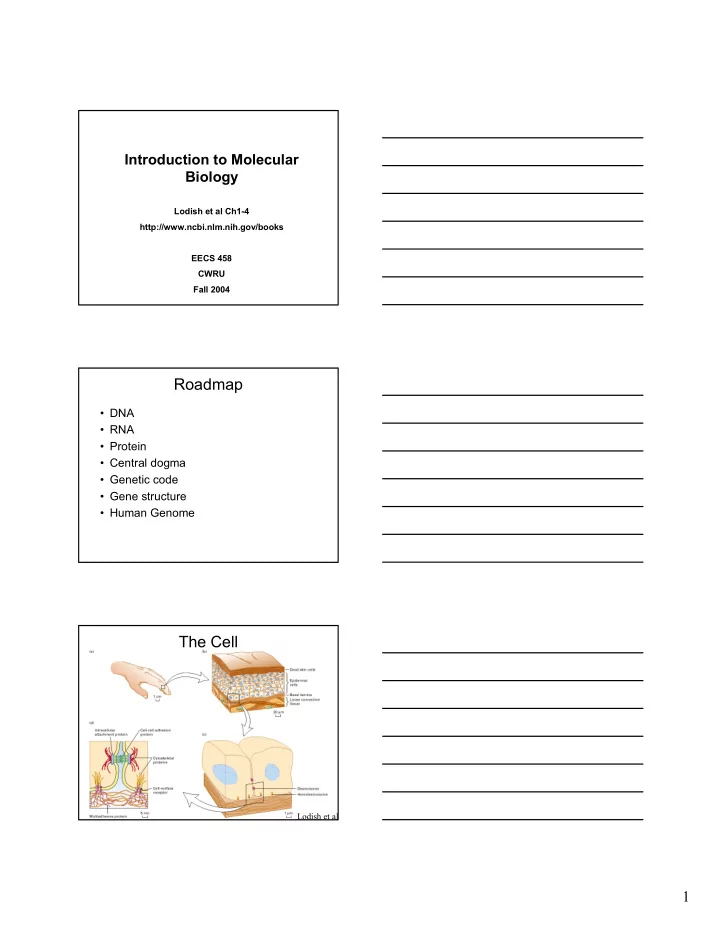

Introduction to Molecular Biology Lodish et al Ch1-4 http://www.ncbi.nlm.nih.gov/books EECS 458 CWRU Fall 2004 Roadmap • DNA • RNA • Protein • Central dogma • Genetic code • Gene structure • Human Genome The Cell Lodish et al 1
Cell Structure: Prokaryotes and Eukaryotes • Prokaryotes: – Single cells without nucleus, (generally) no internal membranes, like bacteria • Eukaryotes: – Multicellular- nucleus, genetic materials in nucleus, all higher organisms 2
DNA • Double stranded chain of nucleotides . • A nucleotide is a single chemical unit with common structure: a phosphate group linked to a five-carbon sugar molecule as the backbone and one of the four bases (A,T,G,C). • The five carbons in a sugar molecule are labeled 1’ through 5’ Nucleotide Bases Watson-Crick 3
DNA Replication • The process of DNA to make an exact copy of itself. • Denaturation: strand separation (by raising temperature). • Renaturation: two separated complementary strands to reform a double helix. • Hybridization: two separated strands to reform a double helix (the extend of hybridization depends on their complementary). 4
RNA • Single stranded • U (Uracil) instead of T (Thymine) • Less stable than DNA • Multiple types: – mRNA (messenger) – tRNA (transfer) – rRNA (ribosomal) 5
Protein • A protein is a chain of amino acids . • Each amino acid has a central carbon ( C a ), an amino (NH 2 ) group, a carboxyl (COOH) group, a hydrogen (H) atom, and one side chain ( R) • 20 amino acids vary only at side chains (R) 20 amino acids: Alanine(A), Cysteine(C), Aspartic Acid(D), Glutamic Acid(E), Phenylanine(F), Glycine(G), Histidine (H), Isoleucine (I), Lysine (K), Leucine(L), Methionine(M), Asparagine(N), Proline(P),Glutamine (Q), Arginine (R), Serine(S), Threonine (T), Valine (V), Tryptophan(W),Tyrosine(Y) Amino acids are linked by peptide bonds between the carboxyl and amino group. Proteins consist of 100-5000aa. Typical length: 300aa. 6
Protein Structure & Function • Primary structure: linear order of aa from N-terminus to C-terminus • Secondary structure: α -helices, β - sheets • Tertiary structure: the 3D conformation • Quaternary structure: protein-protein interactions. Key: function is derived from 3D structure, and 3D structure is specified by amino acid sequence. 7
Central Dogma Replication Transcription DNA Reverse Transcription RNA Translation Protein 8
Genes • A gene is a segment of nucleic acid sequence that is necessary for the synthesis of a functional polypeptide/ protein. • It includes preceding and following the coding region (UTR) and “introns” • Only a small part of genome contains genes. “Junk DNA” • Genes lie in non-repetitive DNA region. 9
10
Translation • The process to make a protein from mRNA. • Take place inside ribosomes, which are made of rRNA and proteins. • tRNA will bring amino acids in. Genetic Code • There are 4 bases (A,C,G,T) in DNA and 4 (A,C,G,U) in RNA, but there are 20 amino acids. How amino acids are encoded in mRNA? 4 1 =4, 4 2 =16, 4 3 =64 • The actual genetic code used by cells is a triplet code. Each triplet is called a codon. Start codon: AUG. Stop codons: UAA, UGA, and UAG. 11
Genetic Code Open Reading Frame Reading frame: Open reading frame: starts with the start codon (AUG), and continue in triplets to a termination codon. It’s important in gene prediction. Genome • The entire DNA sequences in an organism. • In higher organisms, DNA is contained in chromosomes. • The number of chromosomes is a character of a specie. Chromosomes appear in pairs in most higher organisms. (human 23 pairs). 12
Human Chromosomes 22 pairs of autosomes, 1 pair sex chromosomes. The DNA/genes on a pair of chromosomes are not the same. (Alleles) The two alleles at one position is called a genotype. The alleles on one chromosome is called a haplotype. Exactly one chromosome from a pair will occur in a sperm/egg. Human Genome • Contains 3 billion bases. • The total number of genes is estimated around 30,000. • Less than 2% DNAs code proteins. • Repeats make up half of the genome. • The size of a gene is on average 3,000 bases, but vary greatly. • More than half of predicted genes are function-unknown. Human Genome • Genes appear to be clustered randomly along the genome. Gene dense regions are predominantly G/C rich regions. • C p G islands form barriers between genes and “junk DNA” • 99.9% nucleotides are the same in all humans. • Single nucleotide differences (SNPs) occur every 500-1k bases. 13
Image Credits • U.S. Department of Energy Human Genome Program, http://www.ornl.gov/hgmis • Molecular Cell Biology. 4th ed. http://www.ncbi.nlm.nih.gov/entrez/query.fcgi?db=Books • Access Excellence, Graphics Gallery http://www.accessexcellence.org/AB/GG/ 14
Recommend
More recommend